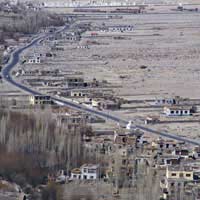
The ancient Indus Valley was home to one of the world’s first great urban cultures. The Indus Valley Civilization flourished in a rich vast river plain and the surrounding regions are now known as Pakistan and the Punjab.
Dominating for 700 Years
The earliest settlements began integration into an extensive urban culture around 5000 years BP (Before Present). Archaeologists rediscovered this ancient Indian civilization which had once predominated the region for more than 700 years, recognising that hidden beneath the red Indian soils was an entire society that built, ruled and developed their lives at the same time as the early Egyptians and the great Mesopotamians.
Harappa Society
The citizens who founded, built and ruled the cities of the Indus Valley are referred to as the Harappa peoples named after the most famous of the archaeological excavations near the modern village of Harappa.
Today’s extant village of Harappa is a true type-site of the ancient Harappa cities. The town lies in the Punjab’s Montgomery District. The villagers here have walked over and across the ancient mounds of the former great city since its decline around 1900 BC. The region appears to have been habitually inhabited throughout history.
Archaeological Excavation
Sir Alexander Cunningham briefly excavated the looming mounds of Harappa during the 1872-73 season. Some twenty years previously, local villagers had robbed the site of its useful building materials, such as bricks, stripping the area of its identifying architectural features and rendering the site more difficult for Cunningham to survey. During his short expedition he found little of interest except an Indus seal.
Extensive excavations were not conducted at Harappa until 1920. Many subsequent expeditions under the auspices of the Archaeological Survey of India were undertaken before independence. Immediately after WW2 Sir Mortimer Wheeler visited the site and excavated what is said to be fortification walls. These and other excavations since have brought to the attention of the world the existence of the lost Indus Valley civilization and it is now recognised that Harappa is the earliest urban cultural setting in the Indian sub-continent.
Many Mounds
Although a small site, of little more than a three mile circle, within this is a host of exciting peaked mounds. Archaeologists have named each mound using a letter system.
The centre of mound A/AB, in ancient times, was continuously rebuilt showing evidence of many settlements. A public bathing area and the town’s water well are located behind a curved wall. The well is one of only eight public and/or private wells found at Harappa leading to the conclusion that water in general may not have been in short supply.
Mysterious Platforms
Between the mounds AB and F are numerous circular platforms originally located inside houses and small courtyards. These mysterious architectural features are thought to be related to the threshing of grain and have been called workman’s platforms since they are near to the Great Granary structure.
The Great Granary?
Mound F contains the Great Granary, a dual set of six rooms on either side of a long passageway, with its earliest strata layers dating to 2500 BC. Although the early European archaeologists, influenced by Continental and Eastern cultural architecture, presumed the arrangement to be a granary, no storage containers or clay storage jar seals, as would be common for the shipment and trade of grain, have ever been found. And, since not one berry of grain has been discovered, archaeological analysts prefer to call these structures simply Great Halls until further excavations bring more clarity to their use.
The extant village nearby still store their grain in earthen granary structures. These small-scale granaries with their re-sealable ground-level-hole access to the grain provide a reasonable counter-example to the Great Granary concept.
Littered with Potsherds
All across the excavation site, along sweeping ridges and filling up shallow valleys are thousands upon thousands of discarded potsherds. The heavy rains, each year, cause fresh surface erosion that brings new pieces of pottery to the surface.
Also brought to the surface are the creeping salt deposits. Many of the reconstructed areas of Harappa show signs of white salt deposits that have crept up from out of the ground causing problems in many areas of the site.
The National Geographic Society continues to fund archaeological research into the early writing of the Indus peoples. Hundreds of inscribed artefacts have been located on the eastern side of mound AB. It is hoped that further discoveries will provide more clues as to the development of early Indus writing.